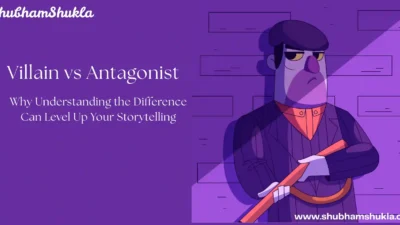Picture this: You’re a few pages into a novel, and a new character steps onto the page. Maybe they saunter into a room, interrupt a tense conversation, or quietly study the world from the sidelines. Whatever the case, you instantly feel something—curiosity, suspicion, admiration. That’s no accident. Knowing how to introduce a character is one of the most powerful tools in a writer’s kit, and when done right, it can hook readers for the long haul.
If you’ve ever wondered whether your character intros are strong enough—or struggled to bring someone to life without dumping paragraphs of backstory—you’re in good company. Let’s break down the art of great character introductions, one relatable example at a time.
You may also like: Real Character Development: 9 Proven Methods To Redefine You
Why Your Character’s First Impression Matters
We only get one shot at a first impression, and the same goes for our characters. A flat or confusing introduction can make a reader feel disconnected before they’ve had a chance to care. On the flip side, a well-crafted entry can spark instant intrigue and emotional investment.
Take Elizabeth Bennet from Pride and Prejudice. We don’t get her life story upfront. Instead, we see her in action—witty, observant, unafraid to speak her mind. Jane Austen doesn’t waste time explaining Elizabeth; she shows us who she is through her behavior and dialogue.
This is the secret to learning how to introduce a character in a way that resonates: make their essence clear from the moment they appear, without slowing the story down.
Pick the Perfect Moment for Their Grand Entrance
Timing is everything. Some stories benefit from dropping the protagonist right into the first paragraph. Others hold off, letting the tension build before the character arrives. There’s no single rule—it’s about what serves your story best.
Remember Jay Gatsby’s entrance in The Great Gatsby? We hear about him long before we meet him. Rumors swirl, curiosity builds, and by the time he turns around with that iconic smile, we’re already invested. This approach works beautifully when you want a character to feel larger than life.
When thinking about how to introduce a character, ask yourself: Do they need to make a splash right away, or would a slower reveal create more impact?
You may also read: Best Durjoy Dutta Books: Top 10 Must-Read Love Stories
Show, Don’t Tell — Let Actions Do the Talking
One of the most effective ways to introduce a character is by showing them in action. Readers are smart—they can pick up on clues without you spelling everything out.
Is your character impulsive? Show them interrupting a conversation or leaping into a decision. Are they reserved? Maybe they hesitate before speaking or avoid eye contact. These tiny behaviors add up and tell the reader more than a laundry list of traits ever could.
Look at Arya Stark in Game of Thrones. From the first few scenes, we see she doesn’t fit the mold of a proper lady—and she’s fine with that. She’s restless, rebellious, and determined. George R.R. Martin doesn’t tell us this—he shows it.
So if you’re working on how to introduce a character, think about what they’re doing, not just what they’re thinking or saying.
Use Perspective and Voice to Your Advantage
Your story’s point of view can completely shape how a character comes across. A first-person intro allows for immediate intimacy—we’re literally inside their head. Third-person limits can keep some emotional distance, while omniscience lets us view them from afar.
Think of Holden Caulfield in The Catcher in the Rye. That voice is unforgettable because it’s so him. Sarcastic, observant, insecure, bold. We’re introduced to Holden through his lens, and it colors every word.
When considering how to introduce a character, don’t forget how the narrator’s voice (whether it’s the character’s or someone else’s) can help or hinder that connection.
You may also like: Top 10 Names of Demons in the Bible
In My Own Experience, I Found That…
…one of the best ways to introduce a character is to drop them into a situation that forces them to reveal something about themselves. Not through exposition, but through reaction.
I once wrote a story where the main character was a perfectionist—but no matter how I described her, she felt flat. Then I rewrote her introduction: she was in the middle of baking a cake, and it collapsed.
Instead of panicking, she calmly scraped it into the trash, took out her recipe book, and started over without a word. That quiet persistence told readers more than any backstory paragraph ever could.
So here’s my advice: if you’re figuring out how to introduce a character, let their personality emerge. Trust your scenes to show us who they are.
Sprinkle Backstory (Don’t Dump It)
It’s tempting to share your character’s full backstory as soon as they show up. But resist the urge. Think of backstory like seasoning—not the whole meal.
We want just enough to get curious. A scar. A mysterious comment. A nervous tic. That’s often more intriguing than telling readers everything up front.
In Harry Potter and the Sorcerer’s Stone, we learn about Harry’s scar and his cupboard under the stairs long before we know the full story behind them. That mystery keeps us reading.
So, when planning how to introduce a character, hold some things back. Let the reader want to know more.
You may also like: Love Doesn’t Live Here Anymore Book Review: Is It Worth the Read in 2025?
Let Them Be a Little Messy
Finally, don’t worry about making your characters perfect in their first scene. In fact, imperfections are what make people relatable. Let your characters stumble, get frustrated, make bad jokes. That’s what makes them real.
Think of Bridget Jones we meet her fumbling through resolutions and social awkwardness, and we can’t help but root for her.
When it comes to how to introduce a character, don’t aim for polished—aim for true.
Wrapping It Up: Start With Connection
Introducing a character isn’t about cramming in every detail. It’s about creating a moment a spark that makes the reader want to know more. Show us something real. Let them act. Let them speak. Let them mess up.
Because once your character feels real to the reader, the rest of the story has something solid to stand on.
FAQ: Quick Tips on How to Introduce a Character
Q1: Should I describe physical appearance right away?
Not always. Focus on what matters—quirks, habits, or behavior can be more telling than hair color.
Q2: Can I introduce multiple characters in one scene?
Perfect! Introduce who they are, not who they’ll become. The growth is part of the arc.
Q3: What if my character changes later in the story?
Perfect! Introduce who they are, not who they’ll become. The growth is part of the arc.
Q4: Is dialogue a good way to introduce someone?
Absolutely. A single line of dialogue can reveal voice, background, and personality in one go.



